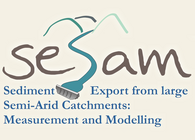Generation, transport and retention of water and suspended sediments in large dryland catchments: Monitoring and integrated modelling of fluxes and connectivity phenomena

SESAM
The 3-year joint research project (2010-2013) funded by the Deutsche Forschungsgemeinschaft (DFG) aims at observing and modelling water and suspended sediment transport processes and connectivity phenomena in two meso-scale dryland catchments in NE Spain and NE Brazil in order to enhance process understanding at spatial scales relevant for water and land management. Project partners are the University of Potsdam, Institute for Earth and Environmental Sciences, the German Research Centre for Geosciences, Hydrology Section and Remote Sensing Section, and partner institutions in Spain (University of Lleida) and Brazil (University of Fortaleza).
Understanding connectivity in hydrological systems is important given the degree to which such connectivity has been impaired by human activities worldwide, e.g. by water abstraction and reservoir construction. Specifically for dryland regions, which host about one-third of the global population and are exposed to the hazard that available water resources fail to meet water demand, the assessment of water and sediment fluxes are a prerequisite for sustainable water and sediment management. Drylands often experience strong erosion in headwater catchments, resulting in reservoir sedimentation and a loss of retention volume which can lead to a significant reduction of water availability within few decades.
This project will quantify and model runoff and suspended sediment transfer paths in dryland regions. Connectivity processes between water and sediment delivering, accepting and transporting compartments, including the analysis of transfer routes and storage capabilities, will be analysed for instrumented meso-scale catchments in Spain and Brazil. Extended multi-scale field monitoring, the quantification of leakiness and landscape fragmentation, the application of innovative sediment tracing techniques, and the identification of major sources, stores and fluxes of sediments through remotely sensed data will result in an enhanced process understanding of connectivity. An existing modelling framework for water and sediment transport, the WASA-SED model, will be extended to account for these phenomena at the intersections of hillslopes, rivers and reservoirs. Large-scale pilot parameterisations for parts of the Ésera Basin in Spain and the Upper Jaguaribe in Brazil will be conducted to evaluate scenarios on land and reservoir management. The expected results will improve the knowledge and modelling capability of connectivity processes of water and sediment fluxes in drylands at spatial scales relevant for water and land management.
Contribution of GFZ Remote Sensing group to SESAM
- Observation of the space-time variability of soil and vegetation parameters for catchment model parameterisation and the delineation of modeling units using field, airborne and satellite spectroscopy
- Quantification of suspended sediment sources using fingerprinting approaches based on the spectral information in order to identify dominant sediment source areas during flood and non-flood conditions
- Monitoring of badland topography, river channel topography and reservoir bathymetry using terrestrial LiDAR to study erosion and sedimentation processes and quantify volumetric changes
Project Homepage:


